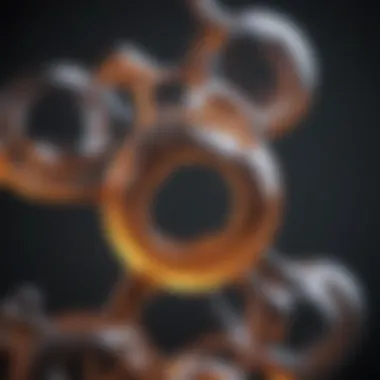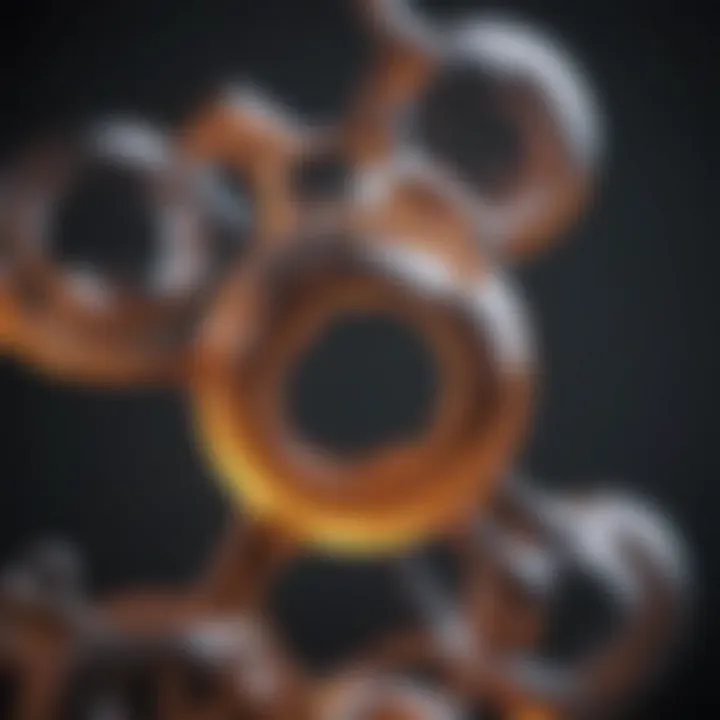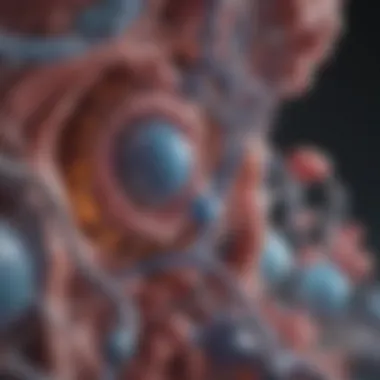Exploring PEG Polymers: Structure and Applications


Intro
Polyethylene glycol (PEG) polymers have become integral in scientific research and industrial applications. Their unique physicochemical properties allow for versatility that permeates diverse fields. Notably, their utility extends from the development of pharmaceuticals to advanced material science. This section sets the stage for a comprehensive examination of PEG polymers, highlighting their structure, synthesis, applications, and the potential challenges and innovations in ongoing research.
Research Overview
This section provides insights into the key aspects of PEG polymers, highlighting recent findings and study methodologies.
Key Findings
- Versatility of Application: PEG polymers are utilized extensively in drug delivery, hydrogels, and as surface modifiers. Their ability to be tailored for specific functions enhances their application range.
- Biocompatibility: This polymer exhibits excellent biocompatibility, making it a popular choice in biomedicine, particularly in drug formulation and tissue engineering.
- Environmental Considerations: Recent studies have stressed the need for sustainable practices in the synthesis and disposal of PEG polymers, signaling a shift toward greener chemistry.
Study Methodology
The examination of PEG polymers typically involves several analytical techniques, including:
- Nuclear Magnetic Resonance (NMR): Used to determine the chemical structure and purity of PEG samples.
- Gel Permeation Chromatography (GPC): Employed for measuring molecular weight distribution.
- Fourier Transform Infrared Spectroscopy (FTIR): Useful for identifying functional groups and chemical bonds.
Background and Context
This section provides context to the prevailing trends and historical significance of PEG polymers, grounding the reader in their development and use.
Historical Background
PEG's journey began in the 1920s, when it was first synthesized. Initially an obscure compound, it gained prominence in the latter half of the century due to its unique characteristics. Research into PEG accelerated during the 1970s, particularly in the medical field, where its hydrophilic nature proved advantageous for drug delivery systems.
Current Trends in the Field
Recent trends in PEG polymer research focus on several cutting-edge applications and methodologies:
- Tailored Drug Delivery Systems: Optimizing the release kinetics of pharmaceuticals.
- Smart Hydrogels: Developing materials that react to external stimuli for applications in regenerative medicine.
- Sustainable Practices: Addressing environmental concerns related to PEG synthesis and biodegradability.
"The dynamic nature of PEG polymers continues to drive exploration in both theoretical and applied sciences, marking an exciting era for researchers."
This overview sets a foundation for delving into the specifics of PEG's chemical structure and its far-reaching applications. As we progress through the article, we will unpack these elements in greater detail.
Prologue to PEG Polymers
Polyethylene glycol (PEG) polymers have attracted significant attention in both scientific and industrial contexts. Their versatile nature contributes to a broad spectrum of applications, ranging from biomedicine to electronics. Understanding PEG polymers is essential for those involved in these fields because it opens doors to innovative solutions. The significance of PEG lies in its unique structure, which allows it to perform various functions effectively.
Definition and Significance
PEG is a synthetic polymer that consists of repeating units of ethylene oxide. This linear structure provides favorable properties such as hydrophilicity, biocompatibility, and low toxicity. The combination of these traits makes PEG suitable for numerous applications. For example, in biomedicine, PEG is commonly used to enhance drug solubility and stability. This polymer is crucial for delivering therapeutic agents effectively to targeted sites within the body, improving treatment outcomes.
Additionally, the relevance of PEG in industrial applications cannot be understated. It is widely used in cosmetics and food processing, where its ability to retain moisture and improve texture is valued. The diverse applications of PEG affirm its importance across various sectors.
Brief History of PEG Use
PEG was first synthesized in the 1920s by an American chemist. However, its commercial use did not take off until the 1960s. In the early stages, PEG's hydrophilic properties caught the attention of researchers. They recognized the potential advantages of using PEG in biomedical applications, particularly in drug formulation and delivery systems.
Over the decades, the utilization of PEG has expanded significantly. It has been integrated into various FDA-approved products, including medications and medical devices. Today, PEG is a staple in research, as its functional versatility continues to evolve. This adaptability showcases PEG’s history as not just a material but also a pivotal resource in advancing science and industry.
The evolution of PEG in both medical and industrial sectors highlights its growing importance in modern applications.
Chemical Structure of PEG
Understanding the chemical structure of polyethylene glycol (PEG) polymers is crucial for appreciating their diverse applications and properties. PEG possesses unique hydrophilic characteristics due to its molecular arrangement, which influences its interaction with other substances. These factors contribute to its roles in fields ranging from biomedicine to materials science.
Molecular Composition


The molecular composition of PEG consists primarily of repeating units of ethylene oxide. This structure is represented as HO-(C-C-O)n-H, where ‘n’ indicates the number of repeating units. The molecular weight of PEG varies significantly, resulting from different polymerization processes that can create short or long-chain structures.
The specific molecular weight of PEG directly impacts its solubility, viscosity, and biological activity. For example, low molecular weight PEGs are often used in drug formulations due to their ability to improve solubility and bioavailability. In contrast, high molecular weight PEGs are useful for maximizing viscosity and providing a more substantial presence in formulations. This adaptability makes PEG an attractive polymer in many industries.
Additionally, PEG's linear configuration and non-toxic nature allow it to be easily conjugated with a variety of compounds, making it a favored choice for drug delivery systems.
Modification of Structure
Modification of PEG's structure can enhance its performance in various applications. These modifications can take several forms, including changes in molecular weight, branching, and end-group functionalization.
- Molecular Weight Engineering: Adjusting the molecular weight can optimize the properties of PEG for specific applications. For instance, increasing molecular weight often leads to improved mechanical properties, beneficial for tissue engineering applications.
- Branching: Introducing branching to PEG polymers can significantly change their properties. Branching can increase the hydrodynamic volume, influencing the solubility and kinetic behavior within biological systems. This structural alteration may be particularly useful when developing targeted drug delivery systems.
- End-Group Functionalization: The chemical groups at either end of the PEG chain can be modified to include various functionalities. This approach allows for the attachment of drugs, peptides, or other biomolecules, enhancing the specificity and effectiveness of PEG-based carriers in therapeutic applications.
In summary, the chemical structure of PEG plays a key role in defining its characteristics and applications in different fields. Understanding both its molecular composition and the possibilities for structural modifications can lead to advancements in PEG research and its usage in innovative applications.
"The versatility of PEG makes it a cornerstone polymer in both scientific research and industry, reflecting its expansive utility across multiple domains."
By examining the data on PEG's structure, researchers can continuously innovate and adapt these polymers for enhanced effectiveness in their respective fields.
Synthesis of PEG Polymers
The synthesis of polyethylene glycol (PEG) polymers is a fundamental aspect of understanding their diverse applications in both scientific and industrial fields. This section will discuss the importance of various polymerization processes used in PEG synthesis, as well as the techniques employed to characterize the resulting materials. By comprehending these processes, researchers can tailor PEG polymers to specific functionalities, making them valuable in numerous sectors.
Polymerization Processes
Polymerization is the chemical process of combining monomers to create a polymer. In the case of PEG, the most common method of polymerization is the process known as ring-opening polymerization. This method allows for precise control over the molecular weight and polymer architecture. The basic steps in this process involve the opening of the cyclic ether epoxide, followed by the addition of other epoxide units.
Some important features of ring-opening polymerization include:
- Control Over Molecular Weight: By adjusting the ratio of monomer to initiator, one can control the average molecular weight of the PEG product. This level of control is crucial, as different applications may require specific molecular weights for optimal performance.
- Low Levels of Side Products: This method tends to produce fewer side products compared to other polymerization methods, such as step-growth polymerization. This leads to a cleaner synthesis and high purity of the final product, which is particularly important in biomedical applications.
- Customization of Functionality: The resulting PEG can be further modified with various functional groups, enhancing its usability in drug delivery systems or biosensors. Functionalized PEG offers the potential to interact with biological systems more effectively.
These characteristics make ring-opening polymerization an attractive option for producing tailored PEG polymers suitable for various applications. However, several other methods exist, such as step-growth polymerization and polycondensation, which may be used depending on the desired end product and its application.
Characterization Techniques
Once PEG polymers are synthesized, it is essential to characterize them to ensure they meet the required specifications for performance and efficacy. Various techniques are used to analyze the structure and properties of PEG, among which the following are prominent:
- Nuclear Magnetic Resonance (NMR) Spectroscopy: NMR is a powerful tool for determining the structure of new PEG products. It allows scientists to assess the composition and detect any impurities or side products that may have formed during synthesis.
- Gel Permeation Chromatography (GPC): This technique is vital for measuring the molecular weight distribution of PEG polymers. It provides insights into the efficacy of the polymerization process and helps confirm the control achieved over molecular weights.
- Fourier Transform Infrared (FTIR) Spectroscopy: FTIR helps identify functional groups within the PEG polymer. This is particularly useful for modified PEG products, allowing researchers to verify the success of functionalization.
- Differential Scanning Calorimetry (DSC): DSC is used to analyze thermal properties, such as melting points and glass transition temperatures, which are critical for various applications involving PEG.
Understanding these characterization techniques is crucial for optimizing PEG polymers for specific uses. Consequently, researchers can ensure that their polymers possess the desired properties for applications ranging from drug delivery to industrial uses.
Proper characterization of PEG polymers ensures that their unique properties are utilized effectively in application spaces.
In summary, the synthesis and characterization of PEG polymers directly influence their functionality and applicability. Through controlled polymerization processes and rigorous characterization techniques, scientists can create PEG polymers tailored for innovative uses in multiple domains.
Applications in Biomedicine
The field of biomedicine has seen considerable advancements through the integration of polyethylene glycol (PEG) polymers. Their unique properties, such as hydrophilicity, biocompatibility, and ability to modify surface characteristics, make them invaluable in various biomedical applications. Researchers have increasingly turned to PEG polymers to enhance drug delivery mechanisms, construct tissue scaffolds, and improve diagnostic technologies.
Drug Delivery Systems
Drug delivery systems utilizing PEG polymers offer significant benefits. One key advantage is their ability to increase the solubility of hydrophobic drugs. This helps in achieving proper dosing in therapeutic settings. Moreover, PEGylation, the process of attaching PEG chains to therapeutic agents, can enhance circulation time within the body. This results from the "stealth" effect, which minimizes protein adsorption and clearance by the immune system.
- Enhanced pharmacokinetics
- Prolonged circulation time
- Reduced immunogenicity
For instance, PEGylated liposomes have been developed, enhancing their efficacy in delivering anti-cancer drugs. These systems not only improve drug accumulation at the tumor sites but also minimize potential side effects.
Tissue Engineering
In tissue engineering, PEG plays a crucial role as a scaffold material. The ability to tailor the physical and chemical properties of PEG allows for the creation of customized scaffolds suitable for specific tissues. This customizability fosters more effective cell adhesion, growth, and differentiation, which are vital for successful tissue regeneration.
- Biocompatibility
- Controlled degradation rates
- Versatile mechanical properties


Moreover, PEG has been successfully combined with bioactive molecules to enhance cell signaling and promote tissue integration. Its hydrophilic nature also supports a moist environment, necessary for cell survival and function. The use of PEG-based hydrogels in 3D bioprinting is an emerging trend, pushing the boundaries of tissue engineering.
Diagnostics and Imaging
In diagnostics and imaging, PEG polymers also play a significant role. They enhance the effectiveness of contrast agents used in medical imaging techniques like MRI and CT scans. The incorporation of PEG can improve the stability and retention of contrast agents in the bloodstream, thereby providing clearer images.
- Improved imaging quality
- Prolonged residence time of agents
- Enhanced targeting capabilities
For example, PEGylated nanoparticles have been explored for their ability to specifically target diseases at the cellular level. These advancements may lead to greater accuracy in early disease detection and monitoring therapy effectiveness.
PEG polymers significantly enhance biomedical applications by improving drug delivery, supporting tissue engineering, and advancing diagnostic techniques.
Industrial Applications of PEG
Polyethylene glycol (PEG) finds itself at the intersection of innovation and utility across various industries. This section delves into significant industrial applications of PEG, illustrating its vital role in enhancing product performance and efficacy. Understanding these applications not only showcases the versatility of PEG but also highlights its importance in formulating products that meet contemporary consumer needs while addressing safety and ecological considerations.
In Cosmetics and Personal Care Products
PEG plays a prominent role in the formulation of cosmetics and personal care products. Its hydrophilic nature makes it an excellent humectant, attracting moisture to the skin, thus enhancing the hydration properties of lotions, creams, and gels. Products like Cetaphil Daily Hydrating Lotion utilize PEG for its moisture-retaining abilities.
- Emulsification: PEG emulsifiers are often included in creams and lotions to stabilize oil-in-water or water-in-oil emulsions. By providing a smooth application texture, they improve user experience.
- Product Texture: The presence of PEG enhances the spreadability of products. This quality is particularly appreciated in formulations like conditioners and hair styling gels where ease of application is essential.
- Solubilization: Fragrance oils and actives can be difficult to incorporate into water-based formulations. PEG allows for the solubilization of such ingredients, ensuring that the final product remains effective and pleasant to use.
In Food Processing
PEG is utilized in the food industry for its functional properties, although its use requires careful regulation by food safety authorities. It acts as an anti-foaming agent and a thickener in various food products.
- Food Preservation: PEG can help in maintaining moisture content in foods, thus extending shelf life. This is particularly relevant in processed items where moisture control is critical.
- Textural Enhancement: The incorporation of PEG into sauces and dressings contributes to a desirable thickness and creaminess, improving the overall consumer experience.
- Non-toxicity: PEG is regarded as safe for consumption, leading to its use in low-calorie sweeteners and as a food processing aid in several applications.
In Electronics Manufacturing
The electronics industry benefits from PEG's unique properties, particularly in manufacturing and assembly processes.
- Thermal Management: PEG compounds can be formulated to improve thermal conductivity in electronic devices. Products like thermal pastes use PEG to help dissipate heat, ensuring components function within optimal temperature ranges.
- Dissolution and Cleaning: In the manufacturing processes, PEG solutions are valuable in cleaning circuits and components, allowing for effective residue removal without damage.
- Preventative Coatings: PEG derivatives can be used as coatings to protect electronic components from moisture and contaminants, thus enhancing their longevity and performance.
"The versatility of PEG stands out as it meets various industrial needs, from cosmetics to electronics, showcasing its unique attributes as a polymer."
Environmental Considerations
Understanding the environmental implications of polyethylene glycol (PEG) polymers is crucial in today’s context of sustainability and pollution reduction. They have notable benefits due to their inherent properties; however, their environmental impact warrants thorough exploration. The discussions surrounding PEG often relate to its biodegradability, the implications of its widespread use, and the potential effects on ecosystems.
Biodegradability of PEG
PEG is notable for its solubility in water and relatively low toxicity. These attributes play a pivotal role in its application and disposal. Biodegradability is an important subject within environmental discussions, primarily due to concerns regarding the accumulation of chemical substances in nature. PEGs, particularly those with low molecular weights, can degrade in natural environments through microbial activity.
Factors influencing this biodegradation include:
- Molecular Weight: Lower molecular weight PEGs are generally more biodegradable. They tend to assimilate more readily into ecological processes.
- Environmental Conditions: Temperature, pH, and the presence of specific microorganisms strongly impact degradation rates.
- Chemical Structure: Modifications made to PEG molecules can either enhance or restrict their ability to break down naturally.
Despite these positive qualities, challenges remain in ensuring that higher molecular weight PEGs do not persist in ecosystems. Continued research is essential to optimize formulations that result in more efficient biodegradation pathways.
Impact on Ecosystem
The impact of PEG on ecosystems is multifaceted. While PEG demonstrates lower toxicity compared to many conventional plastics, its effects must be understood in context. Its introduction in various environments can alter microbial communities or disrupt natural biological processes.
Key considerations include:
- Microbial Interactions: PEG can affect the balance and diversity of microbial populations, which are vital for nutrient cycling and ecosystem health.
- Aquatic Life: While PEG is water-soluble and less toxic, there are concerns over its accumulation in water bodies.
- Terrestrial Impact: The presence of PEG in soils can impact plant growth and soil microbial communities.
The following benefits and considerations should be taken into account during assessments of PEG use:
- Improved formulations can enhance biodegradability without compromising performance.
- Continuous monitoring and regulatory measures must be implemented to mitigate potential negative impacts on ecosystems.


"Effectively addressing environmental considerations is not merely a regulatory compliance matter but a step towards creating a sustainable future for humanity and the planet."
Challenges in PEG Research
The research and development of polyethylene glycol (PEG) polymers present a variety of challenges that merit careful consideration. Understanding these challenges is crucial for advancing the field and ensuring safe and effective applications. This section delves into regulatory issues and quality control matters that impact the use and research of PEG, providing insight into how these factors affect both the scientific community and industries utilizing PEG.
Regulatory Issues
Regulatory issues surrounding PEG polymers arise from their widespread use in various sectors, especially in biomedicine and consumer products. Regulatory bodies, such as the FDA and EMA, impose stringent guidelines to ensure safety and efficacy. Compliance with these regulations is not only critical for successful product development but also for maintaining public trust.
The complexity of PEG's chemical nature can complicate regulatory acceptance. For instance, different molecular weights and degrees of polymerization can result in vastly different biological interactions and pharmacokinetics. This diverse behavior raises the need for clear guidelines on the appropriate use and labeling of PEG-containing products.
Moreover, researchers and manufacturers often face hurdles in navigating these regulatory landscapes. Inconsistent classifications and definitions of PEG derivatives can lead to confusion and delays in approval processes. Therefore, ongoing dialogue between researchers, regulatory bodies, and industry stakeholders is essential to establish compatible frameworks that promote innovation while ensuring safety.
"Success in PEG research requires a collaborative approach to overcoming regulatory hurdles, ensuring both compliance and scientific advancement."
Quality Control and Standardization
Quality control and standardization are integral to the successful implementation of PEG in various applications. The synthesis of PEG involves several steps, and the resulting products must meet specific quality standards to be effective and safe. Inconsistent quality can lead to significant variability in performance, especially in biomedical applications.
A primary challenge is establishing standard protocols for the characterization of PEG polymers. Methods such as size-exclusion chromatography, nuclear magnetic resonance spectroscopy, and gel-permeation chromatography are essential for assessing purity and molecular weight. However, the absence of universally accepted standards can result in discrepancies between laboratories and manufacturers, complicating the reproducibility of results.
Additionally, the exploration of modified PEG formulations necessitates rigorous validation to understand their safety and functional properties. For instance, the introduction of various functional groups may enhance therapeutic efficacy but could also lead to unintended consequences. Therefore, implementing rigorous testing and documentation procedures can help mitigate risks associated with product variability.
Future Perspectives in PEG Research
The exploration of polyethylene glycol (PEG) polymers continues to evolve, making it imperative to consider future directions in this area. As research advances, understanding PEG’s potential can yield significant benefits across various industries. Future perspectives in PEG research not only highlight innovations and emerging applications, but also indicate how this compound can adapt to meet the evolving needs of science and society. A comprehensive exploration of these aspects can improve the efficiency of medical treatments, enhance product formulations, and address environmental concerns.
Innovations in Synthesis
Innovative approaches in the synthesis of PEG are vital for expanding its functionality and enhancing its applications. New techniques are emerging that allow for better control of molecular weight and polydispersity. The utilization of tactics such as controlled radical polymerization and microwave-assisted synthesis are noteworthy. These methods facilitate a more uniform composition of PEG, which can lead to improved performance in various applications.
Moreover, researchers are focusing on biocompatible synthetic pathways. This can ensure that PEG formulations are not only effective but also safe for human use. One significant development includes the use of green chemistry principles in the synthesis of PEG. Adopting environmentally friendly techniques will reduce waste and minimize harmful byproducts. These innovations enable researchers to create tailored PEG polymers with specific characteristics for targeted applications.
Emerging Applications
The emerging applications of PEG polymers illustrate the compound's versatility and potential. In the realm of medicine, PEGylation of therapeutic products can improve pharmacokinetics, leading to extended circulation times in the bloodstream. This is particularly beneficial in treatments such as cancer therapy and gene delivery systems.
Another area of interest involves the use of PEG in smart materials. Researchers are investigating its role in stimuli-responsive hydrogels for use in drug delivery. These hydrogels can release their contents in a controlled manner when exposed to specific stimuli, including pH changes or temperature fluctuations.
Additionally, PEG is also making inroads into the field of nanotechnology. Its ability to form stable colloids enables the development of advanced drug delivery systems encapsulated within nanoparticles. This can enhance the targeting of therapies to specific tissues or cells, thus improving therapeutic outcomes.
In industrial applications, PEG’s role as a lubricant is gaining attention. Its use in machinery and automotive engineering can reduce friction, thereby enhancing the performance and longevity of equipment.
Future research in PEG should focus on expanding the scope of its applications while ensuring environmental sustainability and safety.
Overall, the future of PEG polymers holds considerable promise. As researchers delve deeper into synthesis methods and applications, the implications for both science and industry are vast. Continued investment in PEG research can foster innovations that address current challenges, making it an essential area of focus in materials science.
Ending
The conclusion of this article dives into the essential themes of PEG polymers. Understanding the findings of this article is vital for grasping the implications these materials have across many fields.
Summary of Findings
This article explored PEG polymers by examining their unique chemical structure, synthesis methods, and diverse applications in biomedicine and industry. Key points include:
- Chemical Structure: The molecular composition of PEG allows for various modifications that enhance its properties.
- Synthesis: Different polymerization processes yield PEG with unique characteristics.
- Biomedicine Applications: PEG plays a crucial role in drug delivery, tissue engineering, and imaging diagnostics.
- Industrial Uses: Its versatility extends to cosmetics, food processing, and electronics manufacturing.
- Environmental Considerations: The biodegradability of PEG is an important aspect in evaluating its impact on the ecosystem.
- Challenges: Regulatory issues and quality control are significant barriers in PEG research and production.
- Future Perspectives: Innovations in synthesis and emerging applications highlight the need for ongoing investigation in PEG research.
The synthesis and application areas highlight how versatile PEG is for researchers, scientists, and industries.
The Importance of Continued Research
Continued research into PEG polymers is crucial. As industries increasingly rely on this material for various applications, it is important to explore new synthesis techniques and applications. This ensures that the development meets evolving standards and regulatory requirements.
Moreover, ongoing exploration can lead to new insights into PEG's role in problem-solving. For instance, researchers might uncover new, environmentally friendly ways to produce PEG or harness its properties in innovative ways to address health challenges.
In summary, how PEG polymers are synthesized and applied today will shape future innovations. Greater emphasis on understanding this material will yield benefits across multiple scientific and industrial spheres.







